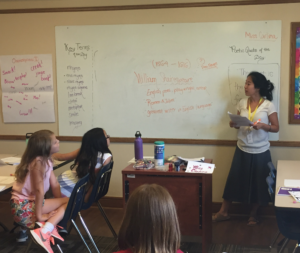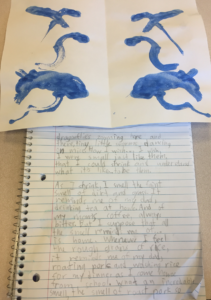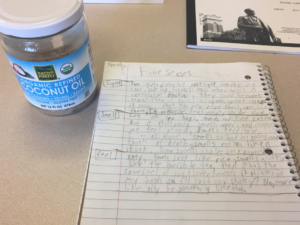Summer SAVY 2018: Session 5, Day 2 – Poetic Play (Rising 3rd/4th)
Posted by morganr1 on Tuesday, July 17, 2018 in Grade 3, Grade 4, SAVY.
Welcome to Day 2! In today’s class, we focused on rhyme and inventive language. Students learned key terms of the day, including: alliteration, rhyme, end rhyme, slant rhyme, rhyme scheme, metaphor, similie, and imagery.
Students spent the morning with a brief communal writing activity, titled, “Exquisite Corpse.” This is a traditional poetry game where each poet writes one line of poetry, folds over the page so the next poet is unable to read the prior line, and hands their new page to a new poet to continue. Students followed a basic template of writing a Vibrant Adjective + Exciting Noun + Juicy Verb per line. The goal of this exercise is for young poets in particular to understand the informal, inventive, and very “weird” (in relation to Writing Guideline #5) ways that poetry might form. It is also to encourage poets to experiment, think outside of the traditional box of what they might be assigned/given, and experience the process of surprise in their writing. During our Exquisite Corpse writing session, some students were instinctively using Alliteration, so we discussed this as a literary technique, as well. Feel free to ask your student about their Exquisite Corpse poem! Most were not unified by similar themes, but did provide for interesting splashes of image and style. We reviewed the five guidelines of Writing within our Exquisite Corpse activities.
Students were then invited to consider the quote of the day, “The poet is the master of the five senses,” by Spanish poet Lorca. We discussed instances of sensory detail in poems we’ve read yesterday, including Whitman’s “Song of Myself” (sniffing the leaves – scent) and Ava Leavell Haymon’s “The Witch Has Told You A Story” (yellow sauce, eggs, butter leaking from muffins – sight/taste). We then commenced with a Sensory Stations activity. Each pair of students was given a different “Sense” — Scent (a jar of peppermint tea), Sound (A jar of oats to shake), Touch (rice grains in a jar), and Sight (three postcards). (To keep things efficient and safe, we did not utilize Taste this morning.) Students were asked to describe the different senses that each “station” conjured up for them — through using descriptive language, onomatopoeia, and the five guidelines of writing. We shared out our writings on the board.
After ORA, students were given an Introduction to Rhyme by reading and watching a video interpretation of “
The Pig,” by Roald Dahl. Students were encouraged to think: What literary effect does rhyme have on the poem? Why might an author choose to rhyme? Students learned the terms “slant rhyme” and “end rhyme,” and were asked to consider the differences and the subtle effects that
slant rhymes might have on unifying a poem’s content, or drawing to attention stark differences between unrelated objects. We discussed how rhyme can transform the tone of the poem by controlling the pace, and students also learned about mood/tone as author’s devices.
Students were introduced to Emily Dickinson, and given a brief overview of her life, her work (the fascicles), and reception to her poems. As a Dickinson fan myself, I had the opportunity to visit Dickinson’s grave and home in Amherst, MA, while at a writing conference last month, so I showed students a few photographs I took of Dickinson’s grave, where literary fans in 2018 have left behind tokens of appreciation for her work — hiking boots, ballpoint pens, to name a few. Students then read her poem, “
Hope is the Thing With Feathers.” Together as a class, we deciphered the meaning of this poem, stanza by stanza, and discussed the use of Metaphor and Slant Rhyme in Dickinson’s work, in order to generate a very fresh portrayal of the very abstract concept of Hope!
After lunch, students played an Inventive Language Game. We discussed Metaphors and Similies. Students were placed in pairs and asked to draw two different nouns from a hat. They then were tasked with discovering the similarities between two seemingly disparate nouns (i.e., “bug” and “computer,” or, “bird” and “mountain.”) Examples of metaphors students came up with: “The ostrich was a torrid volcano, dropping beads of sweat,” and, “Miss Carlina chewed her peppermint treats like a dog chomping his biscuits.” (!) The purpose of this exercise was to introduce students to crafting metaphors, and helping them understand the creative thought-work involved in turning a metaphor into a successful one.
After our game, students took a short snack break, and we then launched into a discussion and reading of William Shakespeare’s Sonnet 18, “
Shall I compare thee to a summer’s day.” Once again, students were briefed on Shakespeare’s writing life and given general biographical data, and a few cool facts (for instance, Shakespeare has 200 references to dogs in his plays, and 600 references to birds!). We analyzed Shakespeare’s sonnet, discussing rhyme scheme (the Shakespearian sonnet rhyme scheme!) and Metaphor — How does Shakespeare use metaphor in order to conjure an ode to his love? What is the mood that the writer is creating through metaphor? We used descriptive language and in-text examples to support our claims!
Lastly, students ended the day with a brief writing exercise. They were asked to create lists of sensory details: favorite textures, a recent scent they remembered smelling, an animal that makes a loud noise, etc., and instructed to free-write verses using the answers on their list. The results were fantastic and poetic, charged and electric, with juicy verbs, repetition, sensory image, and onomatopoeia. Students will resume sharing and writing more tomorrow, in addition to discussing ekphrasis in poetry, and poetry’s intersection with art, music, and other visual culture.
To engage your students in a dinnertime convo tonight, incorporating some of our class terms and techniques, you might consider asking them: Why do you think Shakespeare is considered the “greatest writer in the English language (of all time)”? What guidelines of writing is he following his poetry? / What makes a poem different from a piece of prose? / Why might writers for younger audiences — particularly nursery rhyme authors — choose to use rhyme as a tool? What effect does rhyme have on their readers/listeners?
Thanks for a swell day! I’m excited for tomorrow!
Miss Carlina
Some of Today’s Highlights



